Coordinators:
Alvaro Jaramillo
John Cant
Mars Muusse
Index ORG
ring projects
PDF's
1cy June
1cy July
1cy Aug
1cy Sept
1cy Oct
1cy Nov
1cy Dec
2cy Jan
2cy Feb
2cy March
2cy April
2cy May
2cy June
2cy July
2cy Aug
2cy Sept
2cy Oct
2cy Nov
2cy Dec
3cy Jan
3cy Feb
3cy March
3cy April
3cy May
3cy June
3cy July
3cy Aug
3cy Sept
3cy Oct
3cy Nov
3cy Dec
4cy / sub-ad Jan
4cy / sub-ad Feb
4cy / sub-ad March
4cy / sub-ad April
4cy / sub-ad May
4cy / sub-ad June
4cy / sub-ad July
4cy / sub-ad Aug
4cy / sub-ad Sept
4cy / sub-ad Oct
4cy / sub-ad Nov
4cy / sub-ad Dec
adult Jan
adult Feb
adult March
adult April
adult May
adult June
adult July
adult Aug
adult Sept
adult Oct
adult Nov
adult Dec |
adult: May
Below you will find a description of Chapter 31 WESTERN GULL Larus occidentalis, as published in one of the best Gull publication: "Gulls of the Americas" by Steve Howell & Jon Dunn.
"we" in the text below refers to the original authors. If any errors occur in this text, please let me know and mail to marsmuusseatgmaildotcom.
PART 1 - summary and distribution
PART 2 - similar species
PART 3 - rarer species
PART 4 - Glaucous-winged Gull X Western Gull
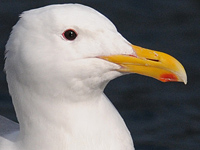 GLAUCOUS-WINGED GULL (w. N. America) a large and robust gull, with proportionately short and broad wings, relatively short wing projection, and stout bill. Wingtip melanism obvious paler than pure Western Gull (in Glaucous-winged similar to upperpart grey tone). GLAUCOUS-WINGED GULL (w. N. America) a large and robust gull, with proportionately short and broad wings, relatively short wing projection, and stout bill. Wingtip melanism obvious paler than pure Western Gull (in Glaucous-winged similar to upperpart grey tone). |
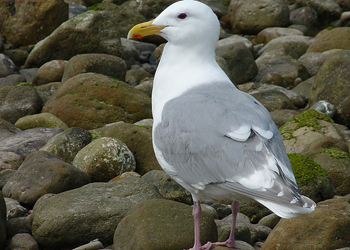 |
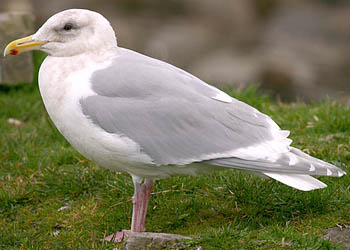 |
| Glaucous-winged Gull glaucescens adult, March 22 2009, Malibu, CA (Hart Walter). Note really pale gray pigmentation on outer primaries and dark iris. |
Glaucous-winged Gull glaucescens adult, March 24 2007, Newport, OR (Greg Gillson). Purple orbital ring and extensive speckling in iris ( >75%). Primary tips are a shade darker than upperparts, medium grey (about Kodak 7). |
 GLAUCOUS-WINGED GULL Wingtips of Glaucous-winged are pale to medium brown, similar in tone to upperparts, which typically have finer and less "frosty" patterning (han Thayer’s). In flight, Glaucous-winged looks plain and less contrasting, without a dark secondary bar and/or contrasting two-tone outer primaries. GLAUCOUS-WINGED GULL Wingtips of Glaucous-winged are pale to medium brown, similar in tone to upperparts, which typically have finer and less "frosty" patterning (han Thayer’s). In flight, Glaucous-winged looks plain and less contrasting, without a dark secondary bar and/or contrasting two-tone outer primaries. |
.jpg) |
 |
| Glaucous-winged Gull (glaucescens) 1st cycle, December 25 2006, Orange Co (John Avise). Replaced upper scaps and several feathers missing in upper row of lower scaps. |
Glaucous-winged Gull (glaucescens) 1st cycle, January 20 2007, Orange Co (John Avise). Compare shade of primary tips relative to brown tone in wing-coverts. |
PART 4: HYBRID GLAUCOUS-WINGED GULL X WESTERN GULL Larus glaucescens x Larus o. occidentalis
LENGTH 22-26.3 IN. (56-67 CM)
IDENTIFICATION SUMMARY
This hybrid combination - sometimes called “Puget Sound Gull” or “Olympic Gull" – is common along the Pacific Coast of N. America, breeding from British Columbia south to Oregon. Nonbreeding migrants occur regularly south to s. California and north to se. Alaska. Hybrids show various combinations of parental plumage and structure (Bell 1996, and see Glaucous-winged Gull and Western Gull accounts) and can also resemble other species, thus causing identification problems. The most common problems are distinguishing Glaucous-winged x Western hybrids from Slaty-backed and Thayer’s Gulls, and they can also be difficult to separate from Glaucous-winged Gull x American Herring Gull hybrids (see Similar Species section for details).
Because hybrids span the range of characters between parental types it is difficult to establish where a pure Glaucous-winged Gull or Western Gull ends and a hybrid begins (Bell 1996). Many birds are clearly intermediate between the parent species, but other hybrids are more subtle. Some adults look like Western Gulls, but their backs are a shade too pale, their wingtips blackish (versus black), their orbital rings mixed yellow and pink, and, in basic plumage, their heads have relatively extensive and smudgy dark markings, and their bills are pale yellowish with dark distal marks. Others look like Glaucous-winged Gulls, but their wingtips are a shade too dark, their orbital rings mixed yellow and pink, and, in winter, they have bright bills typical of Western Gull. Most breeding hybrids from the Juan de Fuca Strait north look more similar to Glaucous-winged Gulls than to Western Gulls, most from the outer coast of cen. Washington south look more similar to Western Gulls (Bell 1997).
First-cycle presumed hybrids also look variably intermediate between the parent species, and their wingtips tend to be some shade of medium brown or dark brown. Birds that look mostly like Glaucous-wingeds can have strongly checked upperparts typical of Western Gull, whereas birds that look mostly like Western Gulls can exhibit delayed PA1 molt and then attain relatively plain, medium gray scapulars typical of Glaucous-winged Gull.
Second-cycle and third-cycle plumages are equally variable.
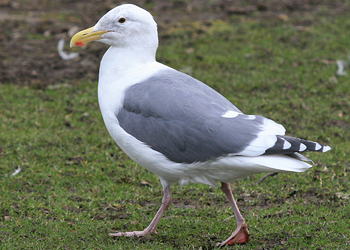 |
 |
| Olympic Gull glaucescens x occidentalis adult, February 16 2009, Portland, Oregon (Lyn Topinka). Purple orbital ring and extensive speckling in iris ( >75%). Medium grey primary pigmentation, obviously darker than upperparts indication for occidentalis influences. |
Olympic Gull occidentalis x glaucescens adult, December 03 2008, Vancouver Island, BC (Guy Monty). Pigmentation on primaries intermediate, and grey tone upperparts intermediate. |
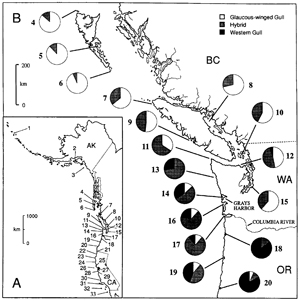 STATUS AND DISTRIBUTION STATUS AND DISTRIBUTION
Common breeding resident a long coasts from s. B.C. to cen. Ore. The hybrid zone extends from Puget Sound and Juan de Fuca Strait south to cen. Ore. (43-49° north) with some introgression north to Queen Charlotte Is. (54° north, Bell 1996) and occasional hybridization south to cen. Calif. (around 38° north; Bell 1997 & Howell pers. obs.). Regular nonbreeding visitor (mainly Oct.-Mar.) north to se. Alaska, south to s. Calif., rarely to n. Baja Calif., and possibly to n. Sonora (Howell pers. obs.). Status inland in w. N. America clouded by difficulties distinguishing hybrids from pure Glaucous-winged Gulls and by a general lack of interest in hybrids among birders. Small numbers winter inland at least to e. Ore.,( Marshall et al. 2003) ; Central Valley of Calif., and n. Great Basin (Floyd 2002). Up to 75 percent of some Western Gull and Glaucous-winged Gull colonies in Wash. and Ore. Comprise hybrids (Bell 1996 & 1997; Hoffman et al. 1978). In cen. Calif.(Marin County), 15-25 percent of the wintering population of Western and Glaucous-winged Gulls typically show hybrid characters, and at some sites up to 50 percent appear to be hybrids (Howell pers. obs.). Hybrids become progressively less common southward along the Calif. coast in winter.
FIELD IDENTIFICATION
SIMILAR SPECIES
Here we deal only with the commonest identification pitfalls caused by birds intermediate between the parent species. For hybrids that closely resemble the parent species, see differences from other species listed in the Glaucous-winged Gull and Western Gull accounts.
Adult Cycle.
THAYER'S GULL (W. N. America in winter). Hybrids are larger and bulkier overall than Thayer’s Gulls with broader wings, shorter wing projection, and a larger and stouter bill. Only the smallest female hybrids are likely to cause difficulties, and even these have stouter bills than Thayer’s (noticeable in direct comparison). Wingtip patterns of hybrids can resemble Thayer`s so closely as to be indistinguishable under field conditions. But hybrids are often slightly darker above (Kodak 6-8. versus Kodak 5-6 on Thayer`s); often show some yellowish in their orbital ring; and can have winter bill patterns varying from bright (like Western) to pale with extensive dark marks (like Glaucous-winged) – unlike the pattern of adult Winter Thayer’s Gulls, which typically have a greenish bill with an orange-red gonydeal spot and a brighter yellow “saddle spot” on the maxilla above the gonys.
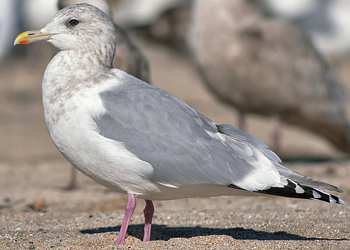 |
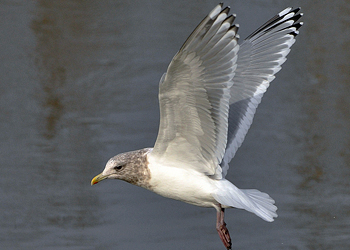 |
| Thayer's Gull adult, mid-January 2014, central California (Amar Ayyash). Purple orbital ring. Small red gonys spot on lower mandible. Pinkish base of bill. Speckling: 75-99% (overall grey-brown iris). Primaries blackish. Thayeri pattern on P10 (see underside). |
Thayer's Gull adult, January 01 2012, Seattle, WA (Amar Ayyash). Thayeri pattern on P9. No black on P5. |
SLATY-BACKED GULL (N. Pacific). Hybrids average bulkier and broader winged with a more bulbous-tipped bill, paler upperparts (Kodak 6-8 versus 9.5-11.5), and their dorsal wingtips tend to be slaty blackish (or paler) rather than black. Wingtip pattern can be similar to Slaty-backed (Glaucous-winged pattern combined with Western Gull darkness) although hybrids with the darkest wingtips generally have narrow whitish tongue-tips and often lack a mirror on P9; and the white trailing edge to the secondaries averages wider on Slaty-backed. Also note Slaty-backed’s reddish orbital ring, more parallel-edged bill, and rich pink legs.
 |
 |
Slaty-backed Gull schistisagus adult, January 21 2011, Choshi, Japan (Stuart Price). Commonly has heavy streaking on head and neck, limited white in wingtip, more 'snouty' head shape. |
Slaty-backed Gull schistisagus adult, January 27 2011, Beijing (Terry Townshend). Large white tips on tertials and secondaries. String of pearls (white tongue tips) on P6-P7. |
AMERICAN HERRING GULL (widespread). Some pale backed, blackish winged hybrids can suggest American Herring Gull but their upperparts are slightly darker (Kodak 6 versus 4-5), wingtips tend to be more extensively blackish, eyes usually dusky (but can be staringly pale), and bill often relatively bulbous-tipped. Also note the thickset and broad-winged structure of hybrids, and check orbital ring for pinkish.
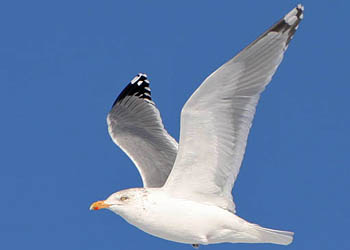 |
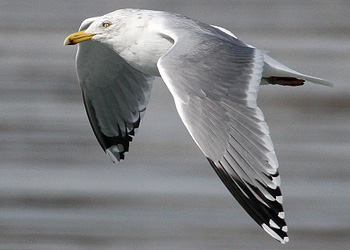 |
American Herring Gull (smithsonianus) adult, February 24 2008, Newfoundland (Bruce Mactavish). |
American Herring Gull (smithsonianus) adult, February 20 2007, Bluff-Point State Park, CT (Mats Wallin). |
VEGA GULL (w. Alaska). Hybrid features such as upperpart tone, dusky eyes, and extensive white tongue-tips and mirrors in wingtip can all suggest Vega Gull - but note thickset and broad-winged structure of hybrids. Also, hybrid wingtips tend to be blackish, not contrasting sharply with gray primary bases; bill often relatively bulbous tipped; and orbital ring pinkish to yellow (reddish on Vega).
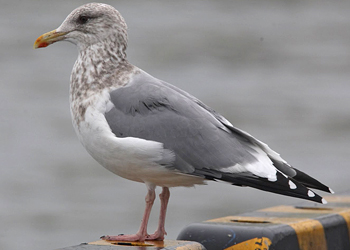 |
 |
| Vega Gull (vegae) adult, December 2009 - January 2010, Choshi, Japan (Chris Gibbins). Dark iris, heavily streaked head continuing on upper breast, dark grey upperparts. Vegae has much black in wingtip. |
Vega Gull vegae adult, July 02 2013, Kamchatka, Russia (Benjamin van Doren. Full sub-terminal band on P5 and P10, with much black on outerweb of P5. Black on outerweb of P4. Black on outerweb of P8, P9 and P10 reach to primary coverts. Red orbital ring, yellow iris. |
HYBRID GLAUCOUS-WINGED GULL X AMERICAN HERRING GULL Can appear similar to hybrid Glaucous-winged x Western, but features indicative of American Herring Gull parentage may be discerned: structure often slighter overall with relatively longer and especially narrower wings and more slender, parallel-edged bill; upperparts average paler (Kodak 5-6, versus 6-8) with more-contrasting and often more-restricted blackish wingtips; and basic head streaking often finer.
 |
 |
Glaucous-winged Gull x American Herring Gull adult, November 20 2011, Westmoreland Park, OR (Amar Ayyash). Pale eyed bird, with many traits of Glaucous-winged Gull. |
Glaucous-winged Gull x American Herring Gull adult, December 30 2011, Tukwila, WA (Amar Ayyash). Glaucous-winged is known for its hybrids with Western Gull (so-called Olympic Gulls), but there also seem to be no shortage of Glaucous-winged x Herring Gulls (so-called Cook Inlet Gulls). These Cook Inlet Gulls tend to show smaller bills than Olympic Gulls. |
HYBRID SLATY-BACKED GULL X VEGA GULL (N. Pacific) not well known. Presumed hybrids (BM #1908.1.8.457 -NE China-) have slaty gray upperparts (Kodak 9) with wingtip pattern similar to Vega Gull: fairly well-demarcated black wingtips both above and below, narrow white tongue-tips on P5-P7 (but not on P8), and no white mirror on P9.
HYBRID GLAUCOUS-WINGED GULL X SLATY-BACKED GULL (N. Pacific) not well known. Could be expected to resemble hybrid Glaucous-winged Gull x Western Gull; critical study needed.
First Cycle.
THAYER’S GULL Besides structural differences (with bill size and shape the most helpful), the following characters help separate hybrids from Thayer’s - but a hybrid may resemble Thayer`s Gull in each feature. Hybrids more often have the tertials, tail, and wingtips similar in tone; hybrids have more-diffuse contrast between outer and inner webs on the outer primaries; hybrids often have more solidly dark tails; hybrids often have more-advanced molt timing, with extensive scapular molt under way by midwinter; and hybrids often have duller, dusky pinkish legs.
 |
 |
Thayer's Gull 1st cycle, February 05 2011, Westmoreland Park, OR. (John Rakestraw). Bird in juvenile plumage by February. Black bill with paler base. Note extensive dark tertial centres and pale crescents on primary tips. |
Thayer's Gull 1st cycle, February 03 2013, Boulder County, CO. (Amar Ayyash). Pale window continues to the inner webs of the outer primaries (base of innerweb of P10 pale). No dark pigmentation on the innerweb tips of P1-P4. Tail largely blackish. Uppertail coverts densely barred. |
SLATY-BACKED GULL Hybrids average bulkier and broader winged with a more bulbous-tipped bill. Slaty-backed upperwing has contrastingly pale inner primaries and more-distinct inner web/outer web contrast on the outer primaries; also note more-extensive white tail base barring and relatively pale greater coverts on Slaty-backed.
 |
 |
| Slaty-backed Gull (schistisagus) 1st cycle, February 13 2013, Rausu, Japan (Mike Buckland). Bulky bird. Few upper scapulars replaced. Simple tertial pattern. Note skirt. Overall somewhat faded brown colour. |
Slaty-backed Gull (schistisagus) 1st cycle, December 27 2009 - January 04 2010, Choshi, Japan (Chris Gibbins).Uniform primaries (with none of the strong patterning (spots, bars) so evident in P1-5 of Vega and Herring Gulls of this age) and uniform greater coverts. Plain tertials and simply patterned second generation scapulars. |
AMERICAN HERRING GULL Structure less thickset overall with relatively longer and especially narrower wings and more slender, parallel-edged bill; primaries and tail black or blackish, darker than hybrids, and with stronger contrast on upperwing between pale inner and blackish outer primaries; bill often has more pinkish at base.
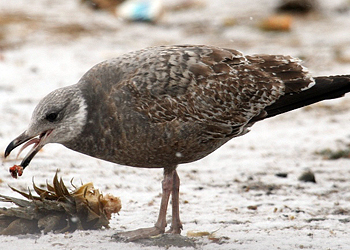 |
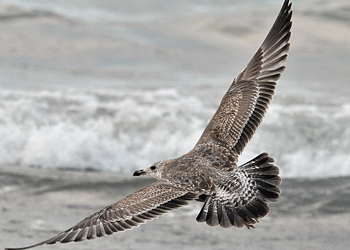 |
American Herring Gull (smithsonianus) 1st cycle, February 09 2008, Dryden, NY (Mike). Brown aspect. Fresh feathers (grey) on hindneck, side of the neck and flank. Crown and ear-coverts replaced as well, throat worn whitish 1st gen feathers. Pale bill base. |
American Herring Gull (smithsonianus) 1st cycle 1106-27465 December 07 2013, New Buffalo, MI (Amar Ayyash). Note paler panel on inner primaries, poor contrast between outer and inner webs on blackish outer primaries, mostly blackish tail and note bill size and shape. |
VEGA GULL differs in same respects as American Herring Gull, but tail averages more extensively whitish basally with a broad blackish distal band, and underparts paler overall with whitish ground color and dusky brown streaking and mottling.
 HYBRID GLAUCOUS-WINGED GULL X AMERICAN HERRING GULL Also called "Cook-Inlet Gull". Besides structural differences, hybrids can show Herring characters, such as a broad dark distal tail band (with more-extensive white markings on outer web of R6 visible at rest) and more-extensive pinkish at bill base. HYBRID GLAUCOUS-WINGED GULL X AMERICAN HERRING GULL Also called "Cook-Inlet Gull". Besides structural differences, hybrids can show Herring characters, such as a broad dark distal tail band (with more-extensive white markings on outer web of R6 visible at rest) and more-extensive pinkish at bill base. |
 |
 |
| Cook-Inlet Gull (glaucescens x smithsonianus) 1st cycle, January 18 2010, Morro Bay, CA (Amar Ayyash). The white edges to the primaries may suggest Thayer's but the size of this individual is much more telling. The upperparts are a bit more frosty than Thayer's and the bill is that of Herring - certainly not Glaucous-winged or Western. |
Cook-Inlet Gull (glaucescens x smithsonianus) 1st cycle, January 11 2007, Rio del Mar, CA (Jeff Poklen). |
HYBRID SLATY-BACKED GULL X VEGA GULL Not well known. Suspected hybrids look intermediate between parent species in structure and plumage characters such as tail pattern and primary pattern, so wingtips blacker than hybrid Glaucous-winged x Western gulls and tails with more-distinct white barring at base; critical study needed.
HYBRID GLAUCDUS-WINGED GULL X SLATY-BACKED GULL not well known; characters relative to hybrid Glaucous-winged Gull x Western Gull need study.
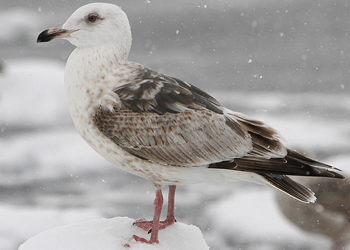 |
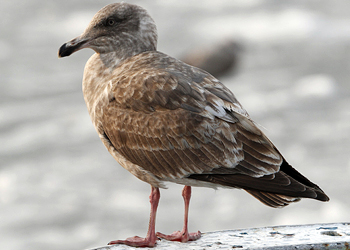 |
Slaty-backed Gull (schistisagus) 2nd cycle, February 13 2013, Rausu, Japan (Mike Buckland). Pale bird on underparts and head. Fresh scapulars indicate upperpart colour of adult plumage. |
Slaty-backed Gull (schistisagus) 2nd cycle, February 13 2013, Rausu, Japan (Mike Buckland). Dark bird on underparts and head. Fresh scapulars indicate upperpart colour of adult plumage. |
Second Cycle.
Plumage highly variable; best identified by structural characters (see adult and first cycle).
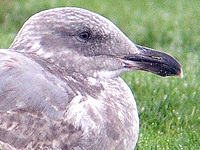 HYBRID GLAUCOUS-WINGED X AMERICAN HERRING GULL, so-called "Cook-Inlet Gull" best separated from Olympic Gull by Herring Gull traits, of which often most prominent is a more parallel bill. HYBRID GLAUCOUS-WINGED X AMERICAN HERRING GULL, so-called "Cook-Inlet Gull" best separated from Olympic Gull by Herring Gull traits, of which often most prominent is a more parallel bill. |
 |
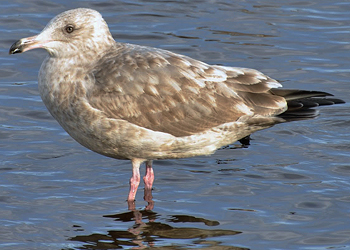 |
| Cook-Inlet Gull (glaucescens x smithsonianus) 2nd cycle, January 01 2012, Sayer's Park, WA (Amar Ayyash). Tend to show smaller bills than Olympics. |
Cook-Inlet Gull (glaucescens x smithsonianus) 2nd cycle, January 01 2012, Mouth of the Cedar River, WA (Amar Ayyash). Tend to show smaller bills than Olympics. |
Third Cycle.
Differences from other species and hybrids much as adult cycle, which see.
HABITAT AND BEHAVIOR
Much as parent species. In cen. California in winter, hybrids resembling Glaucous-winged Gulls feed mostly with Glaucous-winged Gulls (for example, in rocky intertidal areas), whereas Western-like hybrids feed mostly with Western Culls (for example, on sandy mudflats in tidal lagoons and harbors; Howell pers. obs).
DESCRIPTION AND MOLT
Descriptions focus on differences relative to parent species and are not comprehensive. Thus, leg color (pink) and adult tail color (white) are like both parent species and are not noted below.
Adult Cycle.
Complete PB molt (mainly June-Dec.) produces adult basic plumage: variably intermediate between Glaucous-winged Gull and Western Gull. Mantle and primary melanism are good indicators of hybrid origin (Bell 1996). Some birds are almost as pale above as Glaucous-winged Gull but have blackish wingtips, but birds with dark upperparts and pale gray wingtips do not occur (wingtips mainly Kodak 9-16). Back and upperwings gray to pale slaty gray (mostly Kodak 6-8), often with more-extensive white mirrors and tongue-tips in outer primaries than Western Gull; darkest and most Western-like hybrids tend to have reduced white tongue-tips and mirrors and paler, less-contrasting underside to wingtips. Eyes pale lemon (can be more staringly pale than typical of either parent) to dusky. Orbital ring pinkish to chrome yellow; can show patches of both colors or can be an intermediate color such as a fleshy ocher. Bill pale greenish yellow to orange-yellow with orange-red to red gonydeal spot, and often a dark distal mark. Partial PA molt (Oct-Feb.) produces adult alternate plumage: head and neck clean white. Orbital ring, bill, and legs brighter, bill lacks dark distal marks.
First Cycle.
 Juvenile (Aug.-Jan.): resembles a dark Glaucous-winged Gull or a slightly washed-out Western Gull. Intermediate birds often have two-tone outer primaries combining outer web darkness from Western with contrast break at shaft from Glaucous-winged (and thus resemble Thayer’s). Wingtips, tertial centers, and tail often similar in tone, medium brown to blackish brown, or with wingtips or tail blacker; dark secondary bar varies from distinct to muted. Inner primaries often show as relatively contrasting pale inner panel, suggesting Herring Gull. Tail usually looks solidly dark, although outer web of R6 can have some white spots and notches, at least basally. Upperparts range from finely patterned and relatively muted like Glaucous-winged to boldly checkered like Western. Eyes dark, bill blackish and can show dull pinkish basally by midwinter, legs dusky flesh to flesh pink. PA1 molt (starting between Oct. and Feb.) produces first alternate plumage: A1 scapulars vary from grayish with diffuse darker markings, to sooty gray-brown with dark centers. Eyes dark, bill blackish and often with some dull pinkish basally, legs dusky flesh to flesh pink. Juvenile (Aug.-Jan.): resembles a dark Glaucous-winged Gull or a slightly washed-out Western Gull. Intermediate birds often have two-tone outer primaries combining outer web darkness from Western with contrast break at shaft from Glaucous-winged (and thus resemble Thayer’s). Wingtips, tertial centers, and tail often similar in tone, medium brown to blackish brown, or with wingtips or tail blacker; dark secondary bar varies from distinct to muted. Inner primaries often show as relatively contrasting pale inner panel, suggesting Herring Gull. Tail usually looks solidly dark, although outer web of R6 can have some white spots and notches, at least basally. Upperparts range from finely patterned and relatively muted like Glaucous-winged to boldly checkered like Western. Eyes dark, bill blackish and can show dull pinkish basally by midwinter, legs dusky flesh to flesh pink. PA1 molt (starting between Oct. and Feb.) produces first alternate plumage: A1 scapulars vary from grayish with diffuse darker markings, to sooty gray-brown with dark centers. Eyes dark, bill blackish and often with some dull pinkish basally, legs dusky flesh to flesh pink. |
 |
 |
| Olympic Gull (occidentalis x glaucescens) 1st cycle, October 15 2006, Vancouver Island, BC (Guy Monty). Intense mottling with brown (not black) primaries. |
Olympic Gull (occidentalis x glaucescens) 1st cycle, October 28 2011, Clallam County, WA (Steve Mlodinow). Note the dark mask of a Western Gull and the rather dark plumage overall with more GW Gull like primaries. Overall much bulkier than e.g. Herring Gull. |
Second and Third Cycles.
Molt timing and age-related plumage variation parallel parent species (for example, complete PB molts mainly May-Nov., partial PA molts mainly Sept.-Mar.). Plumage and bare parts variably intermediate between parent species; see Adult Cycle (above).
 HYBRID GLAUCOUS-WINGED GULL X WESTERN GULL best separated from. Thayer’s by structure, especially bigger bill; plumage characters need study. HYBRID GLAUCOUS-WINGED GULL X WESTERN GULL best separated from. Thayer’s by structure, especially bigger bill; plumage characters need study. |
 |
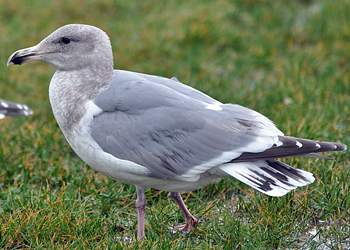 |
Olympic Gull (occidentalis x glaucescens) 2nd cycle, January 02 2012, Gray's Harbor, WA (Amar Ayyash). Bulky bird. Mottled texture as in Glaucous-winged, medium grey tail and primaries as in Western, pale grey upperparts intermediate. |
Olympic Gull (occidentalis x glaucescens) 3rd cycle, January 02 2012, Gray's Harbor, WA (Amar Ayyash). Bulky bird. Mottled texture as in Glaucous-winged, dark grey in tail and primaries indicate Western influence; pale grey upperparts intermediate. |
|
occidentalis Western Gull |


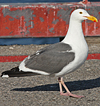 Western Gull occidentalis adult, May 24 2012, Commercial Wharf, Monterey, Monterey Cty., California, USA. Picture: John Cant.
Western Gull occidentalis adult, May 24 2012, Commercial Wharf, Monterey, Monterey Cty., California, USA. Picture: John Cant. Western Gull occidentalis adult, May 24 2017, Pacific Grove, California, USA. Picture: John Cant.
Western Gull occidentalis adult, May 24 2017, Pacific Grove, California, USA. Picture: John Cant. Western Gull occidentalis
Western Gull occidentalis



.jpg)






























